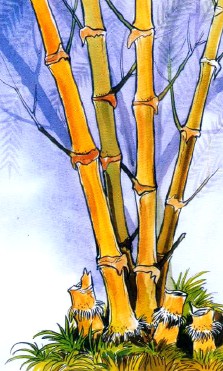|
An
ancient tale from Andaman / retold by Anvita Abbi ; ill. by Partha
Sengupta. - New Delhi : National book trust, 2012. -
[16] p. : ill. ; 18x24 cm.
ISBN 978-81-237-6351-4
|
|
Premier
homme sur les îles, Phertajido lance une volée de
flèches qui l'aident à découvrir l'eau et la
nourriture — puis l'argile avec laquelle il façonne
une effigie : ce sera la première femme. Quand leur
descendance est assurée, Phertajido et sa femme décident
de monter au-dessus des nuages, dans un lieu agréable où
vivent d'autres êtres semblables à eux.
|
DESCRIPTION :
This is the first ever folk tale of the great Andamanese
— believed to be the remnants of the first migration out of
Africa 70,000 years ago — being published by National Book Trust. The
cultural knowledge encoded in the local languages, with special
reference to tribal regions, becomes threatened when elders pass away.
This
tale was told to Professor Anvita Abbi by Nao Jr. on the night of 21
January 2006. Nao Jr. (d. 2009) was so fascinated by this particular
story that he never tired of telling it again and again.
| ❙ | Professor Abbi
taught linguistics at the Jawaharlal Nehru University for 38 years and
has been invited as a visiting professor and researcher at prestigious
institutions in the USA, Europe, Canada, and Australia ; she
served long as an expert from UNESCO on issues concerning languages.
During her studies in 2003-2004, she identified a new language family
of India — the Great Andamanese, which was corroborated in
2005 by population geneticists. — more information : The Kolkata Mail |
|
| INCIPIT |
In
ancient times there lived a man named Phertajido. It is believed by the
Andamanese that Phertajido was the first man who lived on the Andaman
Islands. In Andamanese language Phertajido means “ born out
of bamboo ”. So, it was generally believed that Phertajido
originated from the hollow of a bamboo. He roamed here and there in
search of food for survival and lived alone. He spent most of his time
making bows and arrows.
One day, Phertajido shot his arrows here, there and in all directions. Next morning, he went to search for the shot arrows.
While searching for the arrows, he found one in a spring and drank water from it. This is how he discovered the source of water.
As
he searched for other arrows, he found one hidden in the roots of a
potato plant. This is how he discovered the potato and took some with
him. |  |
|
| COMPLÉMENT
BIBLIOGRAPHIQUE |
- Anvita Abbi, « Endangered languages of the Andaman Island », München : Lincom Europa, 2006
- Anvita Abbi and Patish Sande, « Birds
of the Great Andamanese : names, classification and
culture », New Delhi : Oxford university press India,
2011
- Anvita
Abbi, « Dictionary of the Great Andamanese language :
English-Great Andamanese-Hindi », Delhi : Ratna Sagar,
2012
- Anvita
Abbi, « A grammar of the Great Andamanese language : an
ethnolinguistic study », Leiden, Boston : Brill, 2013
|
|
Anvita Abbi : Vanishing Voices of the Great Andanamese
|
|
|
| mise-à-jour : 8 octobre 2021 |
|
|
|
|